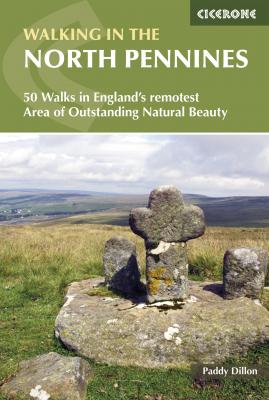Walking in the North Pennines. Paddy Dillon
Читать онлайн.| Название | Walking in the North Pennines |
|---|---|
| Автор произведения | Paddy Dillon |
| Жанр | Книги о Путешествиях |
| Серия | |
| Издательство | Книги о Путешествиях |
| Год выпуска | 0 |
| isbn | 9781783623792 |
Walk 7 Maiden Way – Kirkland to Alston
Walk 8 Blencarn, Cross Fell and Kirkland
Walk 9 Knockergill Pass – Knock to Garrigill
Walk 10 Dufton, Great Rundale and High Cup
Walk 11 Murton, Murton Pike and Murton Fell
Walk 12 Hilton and Tinside Rigg
Walk 13 Mickle Fell via the Boundary Route
Walk 14 North Stainmore and Slate Quarry Moss
Walk 15 Kirkby Stephen and Nine Standards
Walk 16 The Tan Hill Inn and Sleightholme Moor
Walk 17 Bowes and Bowes Moor
Walk 18 Greta Bridge and Brignall Banks
Walk 19 Barnard Castle and the Tees
Walk 20 Woodland and Copley
Walk 21 Cotherstone and Romaldkirk
Walk 22 Tees Railway Walk
Walk 23 Middleton and Monk’s Moor
Walk 24 Middleton and Grassholme
Walk 25 Low Force and High Force
Walk 26 Holwick and Hagworm Hill
Walk 27 Cronkley Fell
Walk 28 Cow Green and Widdybank Fell
Walk 29 Cow Green and Herdship Fell
Walk 30 Wolsingham and Frosterley
Walk 31 Stanhope and Stanhope Dene
Walk 32 Westgate, Middlehope and Rookhope
Walk 33 Chapelfell Top and Noon Hill
Walk 34 Rookhope to Stanhope
Walk 35 Waskerley Way – Parkhead to Consett
Walk 36 Edmundbyers and Edmundbyers Common
Walk 37 Blanchland and Blanchland Moor
Walk 38 Devil’s Water and Hangman Hill
Walk 39 Dipton Mill and Dipton Burn
Walk 40 Allen Banks and Staward Gorge
Walk 41 Allendale Town and Hexhamshire Common
Walk 42 Allendale Town and Allenmill Flues
Walk 43 Ninebanks, Hard Rigg and the Dodd
Walk 44 Alston, Garrigill and River South Tyne
Walk 45 Alston, Lambley and Haltwhistle
Walk 46 Slaggyford and Grey Nag
Walk 47 Allenheads and Killhope Law
Walk 48 Cowshill and Killhope
Walk 49 Killhope Cross and Knoutberry Hill
Walk 50 Nenthead and Nag’s Head
Appendix A Route summary table
Appendix B Useful contacts
The Whin Sill forms a resistant cliff line around the rim of High Cup on the East Fellside (Walk 10)
INTRODUCTION
The North Pennines has been called ‘England’s last wilderness’, and there is nowhere else in the country where the land is so consistently high, wild, bleak and remote. In fact, this is a region of superlatives – once the world’s greatest producer of lead, location of England’s most powerful waterfalls, holding several records for extreme weather conditions, home to an assortment of wild flowers, and refuge for most of England’s black grouse population. The region is protected as an ‘area of outstanding natural beauty’, and renowned for its wild and wide-open spaces.
There is plenty of room for everyone to enjoy exploring the North Pennines, with walking routes to suit all abilities, from old, level railway trackbeds to extensive, pathless, tussocky moorland. For many years the region was relatively unknown, being surrounded on all sides by more popular national parks. Since 1965, the Pennine Way has introduced more and more walkers to the region, many of them being surprised at how wild this part of the Pennines is, especially when compared to the gentler, greener Yorkshire Dales.
When national parks were being established in England and Wales, the North Pennines was overlooked. John Dower described a national park as ‘an extensive area of beautiful and relatively wild country’. The North Pennines features an extensive area of supremely wild country that isn’t matched on the same scale in any of the national parks. The Hobhouse Committee recommended that 12 national parks should be created, and also identified other areas with great landscape value, many of which were subsequently designated as ‘areas of outstanding natural beauty’, or AONBs. The North Pennines was notably absent from all these listings.
When a document recommending AONB status for the North Pennines was presented to the Secretary of State for the Environment, it was promptly filed and forgotten. A concerted lobby brought it back to the fore and a public enquiry was launched. The North Pennines became a minor battleground, with ‘No to AONB’ signs appearing in some places, while some landowners declared that their property had no beauty. In June of 1988 the North Pennines was at last declared an area of outstanding natural beauty, becoming the 38th such designation and, at 2000km2 (772 square miles), also the largest at that time. This was almost immediately followed by a renewed call for national park status to be granted.
The AONB boundary is roughly enclosed, in a clockwise direction,
